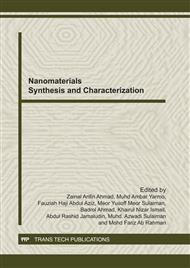p.470
p.475
p.480
p.485
p.489
p.494
p.500
p.504
p.510
Benzoyl Peroxide Initiated Grafting of 3-Aminopropyltriethoxysilane to Multiwalled Carbon Nanotubes
Abstract:
A new method to functionalize multiwalled carbon nanotubes (MWCNT) with 3-aminopropyltriethoxysilane (APTES) has been established using benzoyl peroxide (BPO) as initiator. The functionalization was carried out through free radical reaction by thermal decomposition of benzoyl peroxide at 110°C. The reaction liberated carbon dioxide and generated phenyl free radicals. The phenyl free radicals initiated in-situ functionalization represent a simple means of creating reactive site on the surface of MWNT as well as on APTES. The functionalized MWNT was characterized using X-ray photoelectron microscopy (XPS), X-ray diffraction (XRD) and transmission electron microscopy (TEM). TEM results showed that the APTES has been successfully grafted onto MWNT. Due to the high radical reactive trap of MWNT, APTES radical are easily grafted onto MWNT surface to form covalent bond. XPS results clearly indicate alkoxylsilane and amide groups of APTES were grafted on the MWNT surface with the formation of C-O-Si and C-N bonds as evidence. From the XRD results, it was found that the surface functionalized does not give any effect on the MWNT graphitic structure.
Info:
Periodical:
Pages:
489-493
Citation:
Online since:
October 2011
Authors:
Price:
Сopyright:
© 2012 Trans Tech Publications Ltd. All Rights Reserved
Share:
Citation:


